James Mitchell Crow talks to the organic chemists using electrochemistry to add or remove electrons to their molecules at the flick of a switch
If you were to seek the ultimate expression of elegance and efficiency in complex organic molecule construction, nature’s approach to the assembly of a family of natural products called terpenes would have to be a contender.
The biosynthesis of these densely functionalised, stereochemically complex polycyclic structures begins by linking a few simple starting materials, such as isopentenyl pyrophosphate, end to end. The resulting polyolefin precursor is then zipped up in a cascading, enzyme-catalysed series of ring-closing reactions to deliver the final product.
For almost a century, terpene synthesis has been a yardstick against which synthetic organic chemists have measured the state of their art. The latest tilt at the terpenes, designed to come the closest yet to mimicking nature’s mastery, comes from the labs of Phil Baran at the Scripps Research Institute, and his collaborators.
The team’s strategy was to mimic nature not only in the polycyclisation step – as many previous syntheses had done – but also in the modular combination of simple building blocks to construct the polyolefin precursor. The goal was to find mild, general conditions to clip these building blocks together via decarboxylative carbon–carbon bond forming reactions, thereby offering versatile access to multiple complex terpene natural products rather than a bespoke route to a single terpene structure.
The chemical methods needed to perform the key decarboxylative reaction, however, proved far from ideal. An excess of harsh reagents, cryogenic temperatures, protecting groups and functional group interconversion steps were all required to achieve the transformation.
Every electrochemical reaction that we’ve published is the easiest and cheapest and most direct way to do the reaction
Phil Baran, Scripps
The project, at risk of flatlining, was revived by electrochemistry. ‘The student that started the project, Steven [Harwood], had no idea about electrochemistry – he used it because it saved his project,’ Baran says. Over the past eight years, Baran’s lab has been instrumental in the renaissance of electrochemistry, using electrodes rather than reagents to supply or withdraw electrons to drive organic synthesis.
Thanks to some intra-lab cross-fertilisation, a mild, high-yielding electrochemical procedure, tolerant to different functional groups, for the key polyolefin precursor assembly step was developed. The route enabled the synthesis of not one, but 13, complex terpenes in notably few synthetic steps.
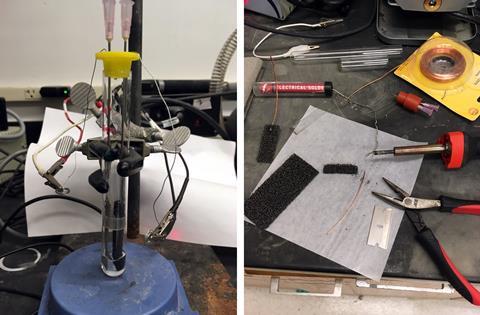
The study is the latest of a rapidly growing list of examples in which electrochemistry efficiently brings about organic transformations that are otherwise either difficult or impossible to complete. ‘If you can do a reaction chemically, and it is easy, then we have no interest in doing it electrochemically,’ Baran says. ‘Every electrochemical reaction that we’ve published is the easiest and cheapest and most direct way to do the reaction.’
Sparked into life
The renaissance in electrochemical organic synthesis is especially remarkable given that, less than a decade ago, almost nobody in academia was using it.
‘When I started around 10 years ago it was this little niche field, no one had a great interest in it,’ says Kevin Lam, an organic chemist turned electrochemist at Greenwich University, UK. ‘There was so much to do in the field, so many unanswered questions – but people would not look at it because there was a huge barrier of activation.’
One factor was that, for synthetic organic chemists, electrochemistry introduces a new and unfamiliar set of reaction variables, from choice of electrode material to mode of electrolysis. Another barrier was the lack of commercially available electrochemistry equipment. ‘You had to really invest time making your own equipment, and learning from other areas of chemistry,’ Lam says. ‘You needed somebody a bit curious to just say “Fine, I am going to do it because I want to know what will happen when you electrolyse something”.’
Lam was not the first to feel this tug of curiosity. The first reported electrolysis of an organic compound, the decarboxylation of acetic acid, was conducted by Michael Faraday in 1834. ‘The history of the field is a bit upside down – it started with Faraday, but really industry took the topic over,’ Lam says. ‘In the 60s the big names are people from industry. The likes of BASF and Monsanto have been doing electrosynthesis for many years but don’t make a big deal out of it.’
The decarboxylation reaction was the reaction first reported by Faraday, and we are still finding new things to do with it
Kevin Lam, Greenwich University
Although the biggest applications are electrolyser-based processes for products such as aluminium and chlorine, industrial applications more akin to organic synthesis do exist. The Baizer process, a cathodic reduction of acrylonitrile to adipontrile, is used to produce polyamides such as nylon-6.6. BASF uses electrochemistry to produce p-tolualdehyde, a building block for the fragrance compound lysmeral, at a scale of over 10,000 tons per year. ‘Other smaller productions are going on and people don’t really advertise it. It is difficult to find, hidden in a patent somewhere,’ says Lam.
What recent academic interest there was in electrochemistry generally focused on energy research, where the priorities are quite different, according to Shelley Minteer, an electrochemist at the University of Utah, US. ‘For things like carbon dioxide reduction, having extremely high efficiency, so that every electron that goes in does the chemistry that you want, is incredibly crucial,’ she says. Whereas for pharmaceutical-type electrosynthesis – or bioelectrosynthesis (see box Electrifying enzymes below) – the emphasis is on selectivity rather than reaching 99% faraday efficiency, she adds.
But wide academic interest in electrosynthesis has recently rekindled. Lam’s lab, seeking to show that electrochemistry is a highly practical method of organic synthesis, has gone right back to the origins of the field. ‘The decarboxylation reaction was the reaction first reported by Faraday, and we are still finding new things to do with it, which I find amazing,’ Lam says. ‘We call it new tricks for an old reaction.’
The reaction is initiated when the carboxylate is oxidised to the carboxyl radical, by single electron transfer to the anode. Decarboxylation then releases the corresponding alkyl radical. If you were to generate these reactive alkyl radicals chemically, you could not do much useful with them, and they just react with solvent or whatever else they meet, Lam says. ‘But by electrochemistry, what really matters is what happens next to the electrode, where the reaction happens. You are able to generate so many radicals that they start recombining with each other.’ As Lam has demonstrated, useful products can result – from intramolecularly cyclised products, to a range of ortho-esters.
‘Around a year ago, we looked at what I call the “unloved children of chemistry” – all these compounds you learn about that could be very useful, but no one is using because it is very difficult to make and commercially there are just a few of them,’ says Lam. ‘My favourites are ortho-esters, a poor little carbon atom with three oxygen atoms on it.’ These species could only be made one way, in a low-yielding process that involved gaseous hydrochloric acid.
‘We developed an electrochemical method to make them that is extremely mild. For the first time you can have functionalised ortho-esters, in good yield, no purification, no need to dry anything,’ Lam says.
Electrochemistry is an easier mode of synthesis than employing fancy air- and moisture-sensitive catalysts, he argues. ‘Our goal is to convince people that using electrochemistry can be a really practical tool that is less hassle than running the reaction in a flask – mix everything, go get a coffee and then come back and get your product.’
Electrifying enzymes
Although electrochemistry can offer striking selectivity, complex substrates can still pose problems. ‘If the window is plus or minus 2 or 2.5V, it is still a pretty small window to do a lot of chemistry. To ensure you do the reaction you want and not a side reaction is always a challenge,’ says Shelley Minteer from the University of Utah in the US.
We know how to drive things very far from equilibrium
Shelley Minteer, University of Utah
Adding enzymes can help. In the Minteer lab, biocatalysis and electrosynthesis are proving to be highly complementary. ‘One of the huge advantages of biocatalysis is that selectivity; the lock and key mechanism with enzymes can really give you a lot of selectivity for the transformation you want,’ Minteer says.
Running the biocatalytic reaction under electrochemical conditions can, in turn, overcome two significant downsides often encountered with enzymes. Common enzyme co-factors such as NADH or NADPH are prohibitively expensive for stoichiometric use, but they can be readily regenerated in situ under electrochemical conditions, so are only required in catalytic amounts. Secondly, the reaction equilibrium is often not shifted toward the product. ‘From an electrochemistry perspective, that’s something we are really good at – if you think about the lithium-ion battery in your cellphone, we know how to drive things very far from equilibrium.’
Minteer has developed methods to run electrochemical biocatalytic reactions under the biphasic conditions often required to get aqueous enzymes to react with non-polar organic substrates. Recent work bioelectrochemically converting dinitrogen into chiral amines really shows the potential of the technology, she says. ‘We’ve taken an enzyme system that hasn’t been viable for scale-up because of cofactor regeneration and the equilibrium being toward reactants, and shown that with one electrochemical system we can simultaneously address both issues.’
Electric shock
While a few synthetic organic chemists have always been drawn to the idea of crafting their own electrochemical cell, for most this necessity has never held great appeal. But sometimes in synthesis, needs must.
Several members of the Baran group were working on the total synthesis of a marine natural product, dixiamycin, when they got stuck at the final step. After trying a long list of oxidants to initiate the desired oxidative dimerisation, nothing had worked. ‘I had to beg the students, on multiple occasions, to run the cyclic voltammogram to find out if there was a chemical oxidant that we could use with the right oxidation potential to do the dimerization,’ Baran says. ‘Nobody wanted to do electrochemistry – whatever the opposite of mainstream is, that’s what electrochemistry was 10 years ago.’
Eventually, out of options, the team tried cyclic voltammetry analysis. ‘They finally did it, and found something remarkable,’ Baran says. ‘When they ran the CV they actually saw dimerisation at a specific potential.’ Either side of the sweet spot, only decomposition or recovery of starting material was observed. The team used these electrochemical conditions to complete the synthesis. ‘We were never able to get dimerisation under any chemical or photochemical condition we looked at,’ Baran says. ‘That to me was the epiphany moment. We’ve got a digital method to modulate the driving force of a reaction and its rate – and yet nobody cares. We decided to figure out why.’
The lack of commercially available, standard electrosynthesis equipment was one obvious impediment. ‘How do you overcome the equipment barrier that made this science basically a bunch of people telling stories around a campfire?’ Baran asks. ‘When we started, everybody had their own method – some people were using lantern batteries, some were using cellphone adapters, some had $5000 potentiostats,’ he recalls. ‘Already the barrier to do this in a company is very high – and now you have to get a PhD in arts and crafts, and a soldering iron and glassblowing equipment and find electrodes? You can just forget about it.’
So the Baran group teamed up with a lab equipment company, IKA. ‘They opened up a site walking distance from our lab, we worked like mad together for two years to figure out how to make a device that would be easy and robust,’ Baran says.

The resulting device, the ElectraSyn 2.0, has become the default bench-scale electrochemical synthesis set-up. ‘The ElectraSyn is a great tool, very convenient,’ says Lam. ‘These days we mostly use them because, if the reaction doesn’t work on the ElectraSyn, you have probably lost 99% of the people who would be interested in what you have done.’ The team does still regularly use its other cells, from larger-scale set ups to a water-cooled design, he adds. ‘At the end of the day, you shouldn’t be limited by the equipment but by the chemistry itself,’ Lam says.
The ready availability of standardised equipment has certainly made it easier for organic chemists to give electrochemistry a try, says Song Lin, who researches synthetic organic electrochemistry at Cornell University in New York, US. For a very long time, organic chemists were resistant to using technologies such as electrochemistry and photochemistry in their labs, he says. ‘It is really only very recently there was a boom in the fusion of technology and organic chemistry. I think the photochemistry community did us a favour, opening people’s mind to doing new things.’
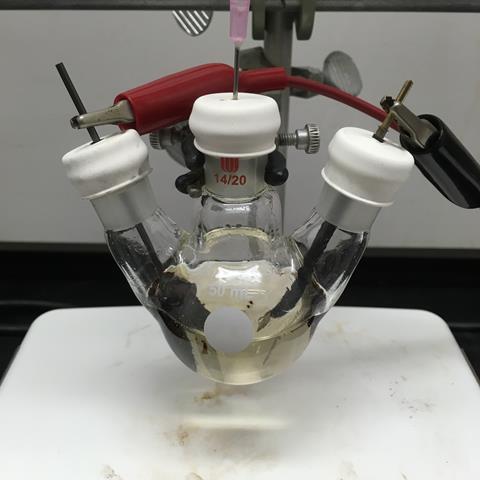
Working with scientists at Merck and Co., Lin’s group recently co-developed a 24 well microscale electrochemical reactor, designed to enable high throughput studies for reaction discovery and optimisation. ‘I think with these standardised reactors, more people will do electrochemistry and the barrier will start to crumble,’ he says.
Using an electrochemical reactor the first few times does remain a learning curve. ‘How to’ guides introducing organic chemists to the process of setting up and optimising an electrochemical reaction have recently been published, including one by Baran and another by Shannon Stahl at University of Wisconsin–Madison, US. ‘There are a few more variables with electrochemistry, which I think makes things more exciting: it gives you the chance to modulate reactivity and selectivity in ways not available in a simple round bottom flask,’ Baran says. Learning to run electrochemical reactions does take a few weeks, he adds. ‘But once they get it, we find people don’t want to stop, a lot of the students find it really fun.’
Proving potential
With the barrier to entry for synthetic organic chemists brought as low as possible, how to tempt more of them to hop over it? ‘Now that the engineering part is done, the only thing left is coming up with reactivity that is provocative,’ Baran says.
Electrosynthesis is solving problems from complex challenges – like terpene synthesis – to simple ones like desaturation of carbonyls to generate α,β-unsaturated aldehydes, ketones, esters and lactams, Baran says. ‘Everyone is using shovelfuls of palladium to remove hydrogen from a molecule – what are we doing?’ he says. With an electrochemical cell, you can do the same transformation, metal-free. ‘You can just pull electrons out and get the same product,’ Baran says.
‘Another one of my favourites is the one we did on rapid alternating polarity,’ Baran adds. By applying rapidly alternating polarity rather than the usual direct current, the team could selectively reduce particular carbonyls among several in a complex molecule. ‘Doing chemoselective reductions just by changing your waveform, it is like stuff from outer space,’ he says. ‘I can’t write the papers fast enough, we have a long list of reactions that I would call “not a gimmick”.’

For redox reactions, it is hard to imagine a better approach ever being devised, he adds. ‘100 years from now, at the larger scales, I can’t imagine a more efficient way of doing redox chemistry than just pumping electrons into the solution directly.’
In each paper, Baran makes a point of comparing the outcome of the electrochemically driven reaction with the conventional chemically driven one. ‘Every electrochemical reaction that we’ve had, either it is the easiest and cheapest and most direct way to do it.’
The pharmaceutical industry is certainly taking notice, Lam says. ‘We have been able to show we can really shortcut the synthesis by using electrochemistry.’ Lam recently worked with researchers from Janssen in Belgium to introduce nitriles to heteroarenes – a common motif in many drug molecules. The previous protocol took several steps, required expensive mediators and hazardous cyanide sources, and had only narrow substrate scope. ‘With electrochemistry we have shown you can do it in one step,’ Lam says. The wide substrate scope and functional group tolerance means the reaction is well suited to late-stage functionalisation of drug candidates. To scale up, the reaction was readily adapted to flow chemistry. ‘They are very happy,’ says Lam. ‘It is solving a real-life problem.’
Lin has also been working on late-stage pharmaceutical functionalisation, with Genentech medicinal chemistry researchers who were chasing the ‘magic methyl’ effect. ‘They wanted us to make a molecule that they have shown to be highly potent once you do a C–H methylation,’ Lin says. Previously, the only way to access the methylated molecule was a 7–9 step de novo synthesis.
One-electron chemistry doesn’t care about your two-electron problems
Phil Baran, Scripps
To achieve direct C–H methylation of the drug molecule, at a carbon adjacent to a nitrogen atom, in a single step, the team re-examined the classic electrochemical Shono oxidation. ‘This reaction is known for decades, but it has mainly been used for small simple molecule synthesis,’ Lin says. ‘The reaction is not compatible with heterocycles and imines, which are really important in medicinal chemistry,’ he adds. Studying the reaction mechanism, the team found that oxidation of the methanol solvent was competing with the desired reaction. By modifying the method, including switching the solvent, the reaction was made compatible with late-stage functionalisation of complex pharmaceuticals or natural products. ‘Now we can just take the drug molecule and directly do a C–H methylation.’
The enabling feature of electrochemistry, Lin says, is its essentially infinite redox range. ‘We can activate some of the most inert molecules, with highly biased potential – but we can also take a complex molecule and just finesse and chose one functional group and oxidise it. That is what is exciting to us.’
The guiding philosophy of the Baran lab is to work toward ideality of total synthesis, eliminating as many ‘non-strategic’ steps as possible. ‘If you are only making skeletal bonds and nothing else, we like it,’ Baran says. When the team recently evaluated its own progress toward synthetic ideality, it noted there was still a way to go, with protecting groups and functional group interconversions still adding unwanted steps.
With its often-broad functional group compatibility, these are just the type of steps electrochemistry could help to eliminate. ‘It is in many cases radical-based, which often makes it much more chemoselective,’ Baran says. ‘One-electron chemistry doesn’t care about your two-electron problems – so we are often able to avoid protecting groups, functional group interconversions, and just go directly to the product.
‘It may be that five years from now we don’t do electrochemistry anymore,’ Baran adds. ‘We’re not trying to push something on anybody, but for our lab and our mission, this seems to be working well. The students love it, it is quite addictive science.’
James Mitchell Crow is a science writer based in Melbourne, Australia
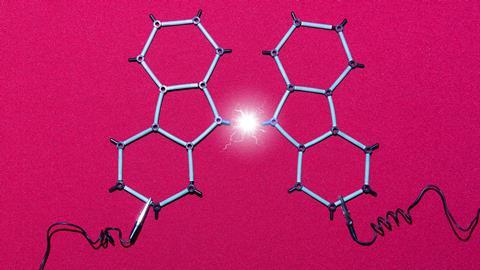

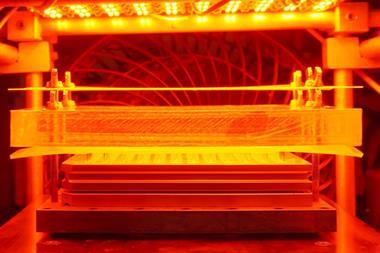

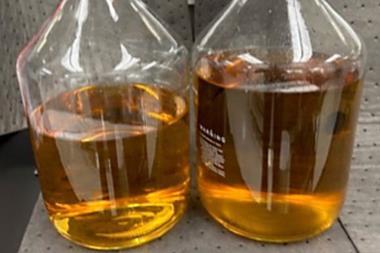

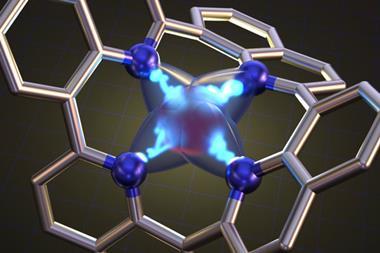






No comments yet